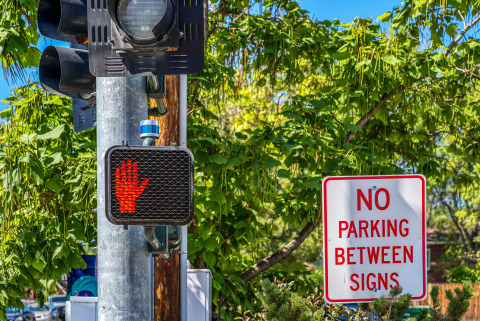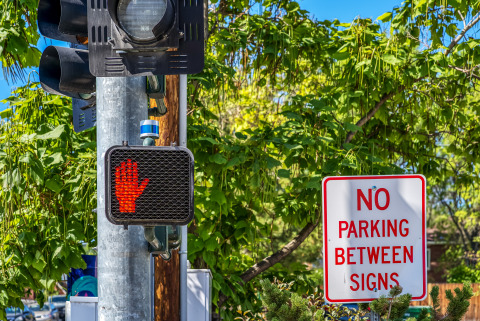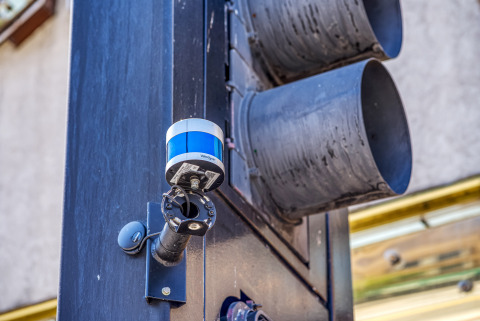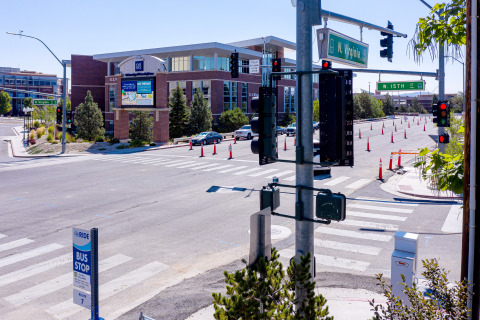SAN JOSE, Calif.--(BUSINESS WIRE)--Velodyne Lidar, Inc. today announced a partnership with University of Nevada, Reno to advance research in transportation infrastructure. The university’s Nevada Center for Applied Research purchased and, in conjunction with the Nevada DOT and Nevada Governor’s Office of Economic Development, is using Velodyne’s lidar sensors in its Intelligent Mobility initiative to collect data aimed at making transportation more efficient, sustainable and safe.
The program has integrated Velodyne Ultra Puck lidar sensors with traffic signals to detect, count and track pedestrians, cyclists and traffic to help improve traffic analytics, congestion management and pedestrian safety. These lidar sensors have been placed at crossing signs and intersections in the city of Reno, Nevada, and because lidar used today does not allow for facial recognition, these smart city applications can preserve trust and anonymity among the public.
“Lidar-enhanced” roads can also communicate data to connected vehicles to support eco-drive and collision avoidance applications. To address roadway congestion monitoring, university researchers have developed speed measurement, and delay and queue length measurements using lidar data.
The program also has an electric bus operated by the Regional Transportation Commission of Washoe County. The bus is equipped with an Ultra Puck and other sensors to collect data to assess mass-transit routes and feasibility of mass-transit automation in city segments with a connected infrastructure.
“Velodyne’s lidar sensors have been instrumental in our transportation research, providing the accurate, reliable 3D data we need in our Intelligent Mobility program,” said Carlos Cardillo, Director, Nevada Center for Applied Research. “Velodyne sensors are helping us address the challenge of improving mobility and safety in transportation, and contribute to advancing smart cities.”
“The Nevada Center for Applied Research is charting a path to create the smart cities of the future by enabling multimodal communication between infrastructure, vehicles and people,” said Jon Barad, Vice President of Business Development, Velodyne Lidar. “Their multidisciplinary research team is using Velodyne’s lidar sensors in innovative ways to collect and analyze data needed to improve efficiency and safety.”
The Velodyne Ultra Puck provides a full 360-degree environmental view to deliver accurate real-time 3D data. It is a small, compact lidar sensor that delivers 200 meters range. The sensor’s reliability and power efficiency make it an ideal solution for smart city applications such as pedestrian safety, vehicle traffic and parking space management, and more. The Ultra Puck does not identify individuals’ facial characteristics, addressing a growing concern for civic applications.
To learn more about the University of Nevada, Reno’s Intelligent Mobility initiative and the coalition of public and private partners actively participating, please go to unr.edu/intelligent-mobility.
About Velodyne Lidar
Velodyne provides smart, powerful lidar solutions for autonomy and driver assistance. Headquartered in San Jose, Calif., Velodyne is known worldwide for its portfolio of breakthrough lidar sensor technologies. Velodyne’s founder, David Hall, invented real-time surround view lidar systems in 2005 as part of Velodyne Acoustics. Mr. Hall’s invention revolutionized perception and autonomy for automotive, new mobility, mapping, robotics, and security. Velodyne’s high-performance product line includes a broad range of sensing solutions, including the cost-effective Puck™, the versatile Ultra Puck™, the autonomy-advancing Alpha Prime™, the ADAS-optimized Velarray™, and the groundbreaking software for driver assistance, Vella™.






